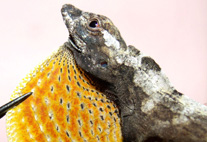Abstract
A small group of six morphologically related seed beetles (Coleoptera: Chrysomelidae: Bruchinae) belonging to the Conicobruchus genus is reviewed. Species in this group for which host-plants are known feed on various species of Crotalaria (Fabaceae, Crotalarieae). Here we provide diagnoses and a dichotomous key for all six species. The following synonymies are proposed: Conicobruchus cicatricosus (Fåhraeus, 1839) (= Bruchus cicatricosus pallidioripennis Pic, 1941) syn. nov.; Conicobruchus strangulatus (Fåhraeus, 1839) (= Bruchus hargreavesi Pic, 1933) syn. nov. The corresponding Conicobruchus strangulatus species group is hereby designated. New host-plant data are also included, which correspond to the results of recent collections of legume pods in East Africa. In addition we carried out molecular phylogenetic analyses on a representative sampling of Conicobruchus species (including the six species of interest). The latter allow us to assess the monophyly of the group of interest and to unravel their evolutionary relationships. Molecular phylogenetic analyses also indicate that at least two lineages of Conicobruchus successfully shifted toward Crotalarieae during the course of their diversification.

